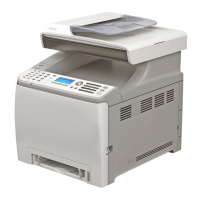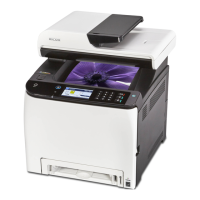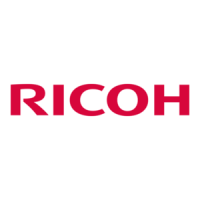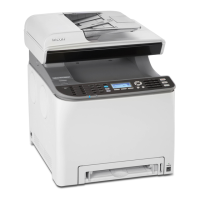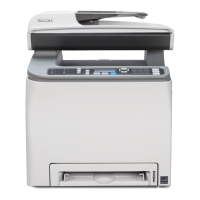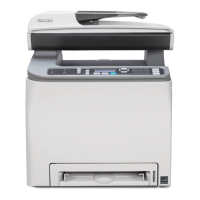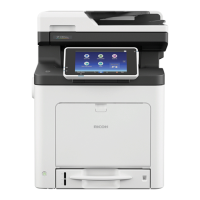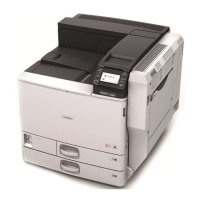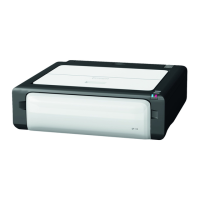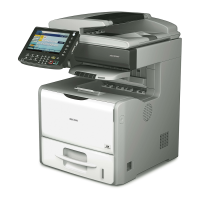What to do if Ricoh All in One Printer is too far from the router?
- DdeborahclarkSep 9, 2025
If your Ricoh All in One Printer is far from the wireless LAN access point (router), move it closer.
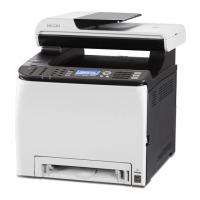
What to do if Ricoh All in One Printer is too far from the router?
If your Ricoh All in One Printer is far from the wireless LAN access point (router), move it closer.
What to do if my Ricoh SP C250SF is not printing pages?
If pages are not being printed by your Ricoh All in One Printer, check that the interface cable is correctly connected and is of the correct type. Try reconnecting the cable to ensure a secure connection.
Why does my Ricoh SP C250SF All in One Printer feed multiple sheets of paper at once?
If your Ricoh All in One Printer feeds multiple sheets at once, fan the paper well before loading it. Also, ensure the edges are aligned by tapping the stack on a flat surface.
How to make paper feed smoothly in my Ricoh SP C250SF All in One Printer?
For smooth paper feeding in your Ricoh All in One Printer, use supported types of paper.
Why is the printed paper wrinkled when using my Ricoh All in One Printer?
If the printed paper is wrinkled when using your Ricoh All in One Printer, use paper that has been stored properly.
Why is the printed paper curled when using my Ricoh SP C250SF All in One Printer?
If the printed paper is curled when using your Ricoh All in One Printer, load the paper upside down in the paper tray.
What to do if the document appears blank when sending a fax from my Ricoh SP C250SF All in One Printer?
If the document appears blank at the receiving end when using your Ricoh All in One Printer, place the original in the correct orientation.
What to do when Ricoh SP C250SF memory is full with fax jobs?
If your Ricoh All in One Printer's memory is full of fax jobs, wait until the pending jobs have been transmitted or printed.
Why can't I configure the encryption key on my Ricoh SP C250SF All in One Printer?
The encryption level specified for your access point (router) may not be compatible. To connect to an operating environment using WEP or TKIP encryption, configure the settings manually or configure the access point (router) to use more secure encryption.
Why do images from the back of the page appear dirty on my Ricoh SP C250SF?
If images from the back of the page appear dirty when using your Ricoh All in One Printer, adjust the image density.
| Print technology | Laser |
|---|---|
| Maximum resolution | 2400 x 600 DPI |
| Time to first page (black, normal) | 14 s |
| Print speed (black, normal quality, A4/US Letter) | 20 ppm |
| Copier resize | 25 - 400 % |
| Maximum copy resolution | 600 x 600 DPI |
| Maximum number of copies | 99 copies |
| Scan to | |
| Scan drivers | TWAIN |
| Image formats supported | JPG, TIF |
| Document formats supported | |
| Optical scanning resolution | 1200 x 1200 DPI |
| Faxing | - |
| Modem speed | 33.6 Kbit/s |
| Fax coding methods | JBIG, MH, MMR (Fax coding method), MR |
| Fax resolution (black) | 200 x 100 DPI |
| Printing colors | Black, Cyan, Magenta, Yellow |
| Maximum duty cycle | 30000 pages per month |
| Page description languages | PCL 5c, PCL 6, PostScript 3 |
| Internal memory | 256 MB |
| Processor family | Intel® Celeron® M |
| Processor frequency | 400 MHz |
| Card reader integrated | No |
| Total input capacity | 251 sheets |
| Total output capacity | - sheets |
| Maximum input capacity | 751 sheets |
| Duplex media weight | 60 - 90 g/m² |
| Paper tray media types | Bond paper, Card stock, Labels, Plain paper, Pre-Printed, Recycled paper, Thick paper, Thin paper |
| Paper tray media weight | 60 - 160 g/m² |
| ISO A-series sizes (A0...A9) | A4, A5, A6 |
| ISO B-series sizes (B0...B9) | B5, B6 |
| Maximum ISO A-series paper size | A4 |
| Product color | Black, White |
| Market positioning | Business |
| Ethernet LAN | Yes |
| Wi-Fi standards | 802.11b, 802.11g, Wi-Fi 4 (802.11n) |
| Cabling technology | 10/100Base-T(X) |
| Ethernet LAN data rates | 10, 100 Mbit/s |
| Standard interfaces | Ethernet, USB 2.0, Wireless LAN |
| AC input voltage | 220 - 240 V |
| AC input frequency | 50 - 60 Hz |
| Power consumption (max) | 1300 W |
| Power consumption (PowerSave) | 3.8 W |
| Power consumption (average operating) | - W |
| Mac operating systems supported | Mac OS X 10.6 Snow Leopard, Mac OS X 10.7 Lion, Mac OS X 10.8 Mountain Lion, Mac OS X 10.9 Mavericks |
| Server operating systems supported | Windows Server 2003, Windows Server 2008, Windows Server 2008 R2 |
| Sustainability certificates | ENERGY STAR |
| Depth | 493 mm |
|---|---|
| Width | 420 mm |
| Height | 460 mm |
| Weight | 29000 g |
Introduces the names and functions of the machine's front and rear parts.
Explains how to place the machine considering environmental conditions and space.
Details how to install optional accessories, like the paper feed unit.
Explains the use of the control panel and Web Image Monitor for machine operation.
Guides through the initial configuration steps when the machine is first turned on.
Describes how to switch between copier, scanner, and fax modes.
Explains the machine's ability to perform multiple jobs simultaneously.
Details the types and specifications of paper supported by the machine.
Provides detailed specifications for different paper types like middle thick and thick paper.
Lists paper types that should not be used to avoid malfunctions or poor print quality.
Illustrates the printable area on paper and envelopes for different functions.
Explains the procedure for loading paper into Tray 1 and Tray 2.
Details how to extend Tray 1 to accommodate longer paper sizes.
Describes the process of loading paper into the bypass tray.
Provides instructions and cautions for loading envelopes into the machine.
Explains the fundamental steps for printing documents from a computer.
Describes how to cancel print jobs from the machine's control panel or computer.
Offers solutions for errors when paper size or type settings do not match the loaded paper.
Details how to use the Locked Print function to protect print jobs with a password.
Explains how to connect a digital camera and print photos directly using PictBridge.
Provides an overview of the display screen when the machine is in copier mode.
Guides through the fundamental steps for making copies.
Explains how to cancel a copy job while scanning or printing.
Describes how to set scaling ratios for enlarging or reducing copies.
Details the procedure for manually setting reduction or enlargement ratios.
Explains combining multiple pages (2 or 4) onto one side of paper.
Guides on selecting combined or 2-sided copying modes and page order.
Explains how to make 2-sided copies of 2-sided originals or combine pages.
Details the steps for performing 2-sided copying using the Auto Document Feeder.
Explains how to perform 2-sided copying using the exposure glass.
Describes how to copy front and back of an ID card onto a single sheet of paper.
Guides on enabling and performing ID card copying.
Explains how to adjust image density and scan quality for the current job.
Details how to adjust the image density for scanning originals.
Explains how to select document types (Mixed, Text, Photo) for optimal scanning.
Guides on selecting the original type to optimize copy quality.
Provides an overview of the display screen when the machine is in scanner mode.
Explains how to register destinations for scanned files using Web Image Monitor.
Details how to modify information for registered scan destinations.
Explains how to delete registered scan destinations.
Guides through scanning files via e-mail, FTP, or to a shared folder.
Describes the basic operation for sending scanned files to e-mail, FTP, or a computer folder.
Explains how to scan files to a USB flash disk.
Details how to specify scanning size, image density, and resolution.
Guides on specifying the scanning size based on the original's dimensions.
Details how to adjust the image density for scanning originals.
Explains how to specify the scan resolution for faxing.
Explains how to scan originals from a computer using TWAIN or WIA.
Describes the basic operation for TWAIN scanning.
Details preparations and procedures for using the TWAIN scanner.
Explains TWAIN scanning capabilities with compatible applications.
Describes the basic operation for WIA scanning.
Provides an overview of the display screen when the machine is in fax mode.
Guides on setting the machine's internal clock for date and time.
Explains how to enter characters using the machine's keys.
Details how to register fax destinations via control panel or Web Image Monitor.
Step-by-step guide to registering fax destinations using the machine's control panel.
Explains how to register fax destinations via the Web Image Monitor interface.
Guides on how to modify or delete existing fax destinations.
Explains how to configure settings to prevent sending faxes to incorrect destinations.
Provides instructions and options for sending faxes.
Explains the two transmission modes: Memory and Immediate Transmission.
Details the process of sending faxes immediately without storing them in memory.
Explains how to send faxes over the internet using TIFF-F format.
Covers the fundamental steps for sending faxes from the machine.
Explains how to cancel a fax transmission at different stages.
Covers methods to specify fax destinations using One Touch buttons, Speed Dial, etc.
Guides on using One Touch buttons to specify fax destinations.
Details how to specify fax destinations using the Speed Dial function.
Explains sending faxes to multiple destinations simultaneously.
Describes how to use the redial function to send faxes to the last used destination.
Highlights useful functions for sending faxes, like On Hook Dial.
Explains using the On Hook Dial function to check destination status before sending.
Describes sending a fax after a telephone conversation without redialing.
Explains how to adjust image density and scan resolution for faxing.
Details how to adjust image density for scanning originals for faxing.
Explains how to specify the scan resolution for faxing.
Explains the two main ways to access machine settings via the control panel.
Lists parameters included in each menu for control panel configuration.
Details settings related to copying functions like paper selection and sort.
Explains settings for scan size, B&W mode, email size, density, and resolution.
Covers settings for immediate transmission, resolution, density, pause time, and headers.
Details settings for receiving faxes, including reception modes and reduction.
Explains how to manage Quick Dial and Fax Speed Dial entries.
Covers various system settings like sound volume, timeouts, and energy saver modes.
Details settings for paper size, type, and priority for each paper tray.
Explains how to configure Ethernet and Wi-Fi settings.
Describes how to print various machine lists and reports.
Details settings related to printing, including copies, paper size, duplex, and fonts.
Covers administrative settings like date/time, function priority, and security.
Explains how to access and use the Web Image Monitor interface via a browser.
Guides on accessing and navigating the main page of the Web Image Monitor.
Details how to check machine status, toner levels, and counter information.
Explains how to configure system settings through Web Image Monitor.
Guides on setting up network configurations like Ethernet and Wi-Fi.
Explains how to register scan and fax destinations using Web Image Monitor.
Details how to register special senders for fax reception control.
Explains how to configure user-based restrictions on machine functions.
Guides on setting up network configurations like Ethernet and Wi-Fi.
Provides instructions and cautions for replacing the print cartridges.
Details the procedure for replacing the waste toner bottle.
Explains how to replace major components like the transfer unit.
Guides on replacing the intermediate transfer unit.
Details how to replace the fusing unit and transfer roller.
Provides important safety precautions to follow during cleaning.
Explains how to clean the toner density sensor.
Guides on cleaning the friction pad and paper feed rollers to prevent misfeeds.
Details how to clean the registration roller and paper tray.
Explains how to clean the exposure glass and the Auto Document Feeder.
Provides solutions for various paper jam messages and locations.
Explains how to remove jammed paper related to printing.
Guides on removing paper jams from the fusing unit.
Details how to remove paper jams from Tray 1 or Tray 2.
Explains how to remove paper jams from the transfer unit.
Guides on how to remove paper jams from the Auto Document Feeder (ADF).
Lists common operational problems and their solutions.
Troubleshoots issues related to paper feeding and jamming.
Addresses common issues affecting the quality of printed output.
Provides checks for machine condition that might affect print quality.
Guides on checking printer driver settings for print issues.
Covers various printing problems and their solutions.
Offers solutions for general printing failures and job cancellations.
Addresses issues like blurred or smudged printouts.
Troubleshoots issues related to making copies.
Provides solutions for unclear or distorted copies.
Addresses issues with copy order, darkness, or tone.
Covers issues encountered during scanning operations.
Troubleshoots problems with network scanning.
Addresses issues where scanning does not produce expected results.
Covers common problems related to sending and receiving faxes.
Provides solutions for issues with fax transmission and reception.
Explains error codes and status messages that may appear on the machine's screen.
Details functions and network settings that differ in an IPv6 environment.
Lists various functions supported by the machine, like FTP printing and scanning.
Explains the capabilities of the Web Image Monitor for machine management.
Describes how to print a page showing machine configuration and IP address.
Covers transmission and reception of Internet Faxes.
Explains the use of IPsec protocol for secure network communications.
Details the encryption and authentication functions within IPsec.
Explains how encryption key exchange and SA settings are managed.
Outlines the steps for specifying encryption key exchange settings.
Guides on configuring encryption key exchange settings via Web Image Monitor.
Provides instructions for setting up IPsec SA settings on a computer.
Explains how to enable or disable IPsec using the machine's control panel.
Provides important notes and recommendations regarding toner cartridges.
Offers cautions and procedures for safely moving the machine.
Advises on proper disposal of the machine.
Directs users to contact sales or service for further information.
Lists and describes the machine's consumables.
Provides details on the average printable pages per cartridge type and region.
Details the average printable pages for the waste toner bottle.
Lists general, printer, copier, and scanner specifications.
Covers general specifications like configuration, print process, and paper sizes.
Details specifications related to printing functions like speed and resolution.
Lists specifications for copier functions such as resolution and copy speed.
Provides specifications for scanner functions like scanning area and resolution.
Details specifications for fax transmission and reception, including access line and scan density.
Lists specifications for optional accessories like the paper feed unit.
Provides copyright information for installed software applications.
